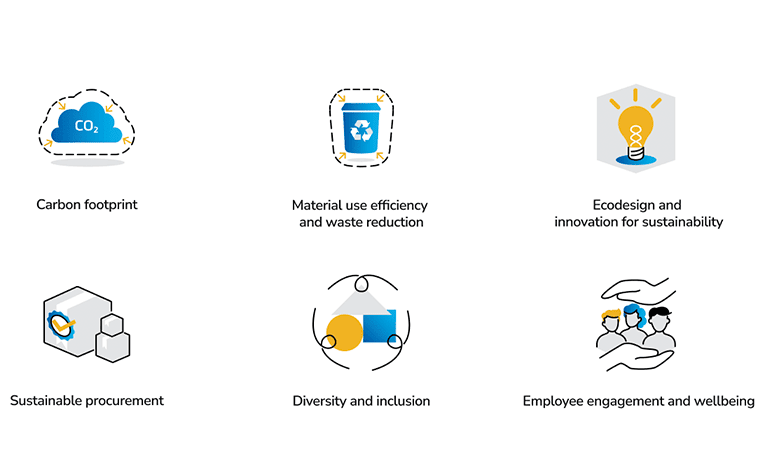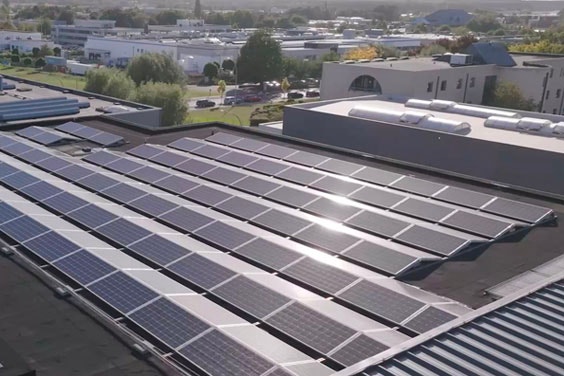
INTERVIEW
Actions You Can Take to Build Sustainability into Your AM Business — And Why You Should Do So
Recently, sustainability has been top of mind for companies and consumers, and it’s now seen as an emerging trend in additive manufacturing (AM), also known as 3D printing. However, how can companies leverage this important societal goal and build sustainable techniques strategically into their existing processes? We spoke to Sherri Monroe, Executive Director of the Additive Manufacturer Green Trade Association (AMGTA), and Leen Kuijken, Head of Sustainability and Corporate PMO at Materialise, to share expert insights and explore the short- and long-term actions businesses using AM should take to build sustainability into their frameworks.
Hi Sherri and Leen. Thanks for joining us today. You both started your new positions this year (2022). How are you finding your new roles, and what led you here?
Sherri: Thanks for having me. I joined the AMGTA in May and am excited to be here. However, I don’t come from the AM world. My background is more related to working with diverse stakeholder groups and associations, but I also have experience working in innovative environments. And although the AMGTA is a young organization, I see parallels between us, where AM is heading in the future and the growth of sustainability.
My first day on the job was at the AM Summit in May, and it was a rapid couple of days. I’ve been to many conferences in my career, but I’ve never been in a room with so much energy and spirit for collaboration — even between competitors. It reminded me of a group of 20-year-olds wanting to change the world, which was amazing. Everyone realized that by working together and moving quickly, we’d grow our pie, and there’ll be plenty to go around. The opportunity to talk with peers and elevate the conversation was great — and this is an exciting time.
Leen: I share Sherri's enthusiasm for where the industry is heading regarding sustainability. I also started my role at the beginning of this year; however, I’ve been at Materialise for a long time in various positions. Like Sherri, I was not born into the AM world (I come from the financial sector). In fact, I’m combining my role as Head of Sustainability with responsibilities in the Project Management Office. It fits rather well because this new role coincided with our company’s construction of a sustainability roadmap.
I have experience with roadmap construction and execution in previous roles in different departments internally and outside of Materialise. Sustainability is extremely close to my heart and is the red thread in my life. In fact, I’m president of the local nature conservation society in my hometown, Leuven, where we preserve nature reserves, encourage nature walks, and incentivize people to think about nature and biodiversity.
From a long-term perspective, what elements are necessary for companies and organizations to improve in terms of sustainability?
Leen: It’s important to realize that what is important may differ from organization to organization, just as the impact they can have. However, it’s important to stress that we’re dealing with huge, long-term challenges that need a long-lasting approach. Consequently, I believe there’s no better way to embrace these challenges than by creating a roadmap. Before defining a roadmap, however, the company should involve a broad group of internal stakeholders to outline the organization’s sustainability strategy and direction. At Materialise, we’ve defined a materiality matrix to figure out the key areas we will focus on and where we, as a company, can add to the sustainability discussion.
We’ve selected six areas in our materiality matrix and have goals on these, like specific reduction targets within a specific time, being transparent about our carbon footprint, etc.


Engaging with people about complicated topics such as sustainability targets takes a while. Therefore, you need to find ambitious, long-term targets and start working within the business. After a company has set its goals, it should seek external validation and open a dialogue with reputable sources. After this, the company can establish and implement the appropriate working groups, owners, and projects. It helps if you have a sustainability team at the heart of your long-term strategy, but companies should make sure this is not only a bottom-up grass movement: support must come from senior people at the top, too. Finally, the company must communicate its progress internally and externally, even in the implementation phase.
This is considered best practice in the market and what we’re doing. Progress might be bumpy, and that’s the risk we’re taking. But it’s important to show that this journey is far from easy. Nevertheless, even if we fail to reach our targets, we’ll still have made important steps, and our actions will benefit the industry in the long run.
Sherri: I absolutely agree. It takes effort from all levels of an organization from the ground up. For example, it’s important that new engineers — who are being trained in innovative, sustainable practices — receive appropriate training and bring that into the company. But you can’t expect a 22-year-old engineer to change everything; changes must come from the top. Also, sustainability shouldn’t be seen as an extra on the side. It has to be a core part of any business, not just in AM.
As Leen mentioned, defining a roadmap and the KPIs are critically important, along with addressing and measuring the results. I believe the measurement stage is a critical step in the evaluation process, as this can stop people from “gaming the system.” Organizations must analyze and constantly tweak things to get the most accurate information. However, sharing any research results, such as from a life cycle analysis (LCA), is great as this information is transferable. That’s what the AMGTA is trying to provide, a platform for knowledge-sharing and the opportunity for partners to collaborate on projects and move things forward on a detailed, operational level. We’re committed to doing this and willing to help other companies along the way.
When new initiatives are discussed, leadership is often mentioned. However, collaboration and partnerships seem to be important as well — why is working together a key factor for sustainability in the future?
Leen: Leadership is important, but it isn’t the goal; the goal is to be more sustainable. You can only reach that via partnerships, and bringing the brightest minds in the industry together can only increase the speed of innovation. The UN’s Sustainable Development Goals (SDGs) highlight partnerships as a key goal, and we selected this area within Materialise as something we’re actively working on. A couple of months ago, we partnered with Arkema to bring new life to our polyamide scrap powder — this recycled powder reduces waste and is an important step towards more circularity. Furthermore, we’ve collaborated with BASF and Sindoh in the past, and we’ll collaborate with more companies in the future. It’s hard to consider where we would be without partnerships.
Sherri: Following on from that point: partnerships allow us to see the flow of information. We can see what’s in demand and what the customer wants. The more information that flows up and downstream between companies, governments, vendors, etc., the greater the chance we have to accelerate the development of products and services within the industry and provide more sustainable production.
Building a sustainability roadmap takes time and spans many years: are there any quick wins companies can implement now while creating this plan?
Leen: There are quick wins, but you need to know where to look. For example, understanding your energy usage, the different types you consume, and converting to renewable, sustainable energy sources as much as possible, will help immensely. Now, we have approximately 95% of our worldwide electricity from renewable sources. That’s probably the easiest, quick win. Another quick win is analyzing your transportation usage. Once you’re aware of certain metrics, you can set specific targets, like electrifying your fleet of company cars and reducing your internal and business flights.


Ideally, this all starts with calculating your emissions and deciding where to make significant reductions. Setting a carbon budget — the maximum amount of CO2 you want to spend e.g., on business travel — and assembling projects that tackle lowering emissions would certainly be constructive. Along with reviewing our energy and transportation usage, we’ve identified that emissions related to the production of the powder we print with is a big component of our emissions. We’ve invested a lot into ways to print more efficiently and have reused waste powder more effectively over the years.
Sherri: I’d like to add that quick wins can occur in different ways: what you do in your company is one way, or what service you provide to your customers is another. If the equipment you provide to your client runs more efficiently, that doesn’t necessarily help your customer in terms of sustainability. However, if that product helps others be more sustainable, that brings tremendous value and should also be included.
Also, just get started if you’re discouraged and don’t know where to start. Begin with the easiest thing, get people on board with the idea, and go from there. It might come off as greenwashing to some people, but quick wins are more baby steps.
What determines whether something is greenwashing or convenient marketing is based on the company’s next action(s). Is the company continuing to do the easy things, or is it progressing to more complex objectives? Customers, employees, and investors quickly see through a lack of commitment. Sustainable actions should permeate every aspect of the company. While characteristics like location and cultural business practices may influence the conversation, creating the mindset within the company is the start. And that comes from leadership.
We’ve passed your “100 days in the office” moment, but what would you both like to achieve personally in 2023 regarding sustainability?
Leen: For Materialise, I’d like to see the roadmap we’ve set up gain traction and be implemented company-wide by different process owners within the organization. Externally, I’d like our example to inspire other companies to take similar steps. By going through this process and telling our story, I hope we can help others move a bit faster and help them have fewer questions down the same road. That would be an outstanding achievement in 2023.
Sherri: I agree. It would be wonderful to see more companies following Materialise’s example by pushing ahead with a roadmap and implementing sustainable actions. Our organization wants to continue building coalitions with companies that are on board with sustainability, as we have members throughout the entire ecosystem, from suppliers and manufacturers to consumers and retailers. Bringing all these groups together — while pushing and expanding what the AMGTA is doing — and sharing best practices concerns us the most in 2023.
If we can spare companies from learning hard lessons and help them avoid wasting time, energy, and money, that will propel them in the right direction. So, that’s our main aim, as well as to continue raising questions and increasing the discussion about sustainability worldwide. We want parity across the regions so that everyone is on a level playing field; we can only do that by raising the conversation.
Finally, what are your key takeaways for the AM community? What should companies do to successfully implement sustainability into their organizations?
Leen: If you’re serious about sustainability in AM, make sure you start by organizing yourself in a sustainable way. For us, that meant switching to renewable energy sources wherever possible. Next, create more transparency by understanding your emissions and where you could make noticeable reductions. Finally, you need to innovate and invest — figure out the gaps and problems you’ll inevitably encounter and think of original ways to solve them. That’s what I’d advise AM and non-AM companies to do.
Sherri: Plus, companies shouldn’t consider sustainability as something separate from your strategic business objectives. Sustainability sits alongside these objectives across all levels of business, such as being more efficient, less waste, and less energy consumption. These goals will naturally lead to shorter lead times and more efficient supply chains: targets that drive every business. So, remember that sustainability is part of every aspect of your business.
Want to hear more from Sherri and Leen? They explain why sustainability is important in AM industry, if the industry is taking it seriously, and the roles LCAs play in keeping companies accountable in a follow-up article planned for next year. Until then, why don’t you explore our impact and how we’re empowering the choice for sustainability?
Share on:

Biography
Sherri Monroe

Biography
Leen Kuijken
You might also like
Never miss a story like this. Get curated content delivered straight to your inbox.
